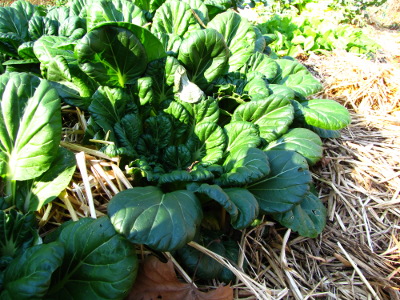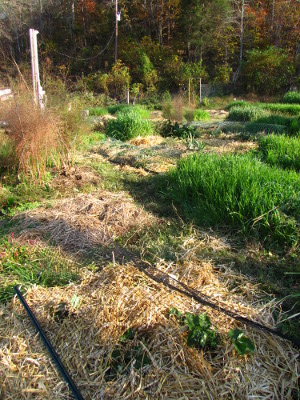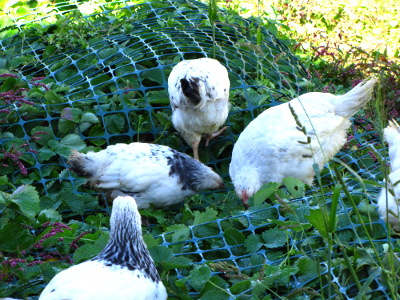
Putting the garden to bed
 I
think of October as "putting the garden to bed month." It's a bit
of a misnomer because my garden never sleeps. Even though the
summer crops are nearly done, the mule garden is vibrant with half a
dozen varieties of leafy greens, lettuce, and the few broccoli and
cabbage plants that germinated in the summer heat. There are
carrots bulking up, garlic and potato
onions already
poking out of the ground, and beds and beds of oat
and radish cover crops.
Strawberry leaves will stay green all year if I can protect
them from the deer
and parsley and Egyptian onions will feed us fresh herbs
through the winter.
I
think of October as "putting the garden to bed month." It's a bit
of a misnomer because my garden never sleeps. Even though the
summer crops are nearly done, the mule garden is vibrant with half a
dozen varieties of leafy greens, lettuce, and the few broccoli and
cabbage plants that germinated in the summer heat. There are
carrots bulking up, garlic and potato
onions already
poking out of the ground, and beds and beds of oat
and radish cover crops.
Strawberry leaves will stay green all year if I can protect
them from the deer
and parsley and Egyptian onions will feed us fresh herbs
through the winter.
 So I guess I should call it
"weeding and mulching month." The goal is to get every weed out
of the garden before it goes to seed and then to cover any patches of
bare ground with mulch. I never quite achieve that dream before
cold weather makes weeding an act of cold finger stoicism, so near the
end I tend to cut corners and just toss mulch on top of small weeds
without rooting them out.
So I guess I should call it
"weeding and mulching month." The goal is to get every weed out
of the garden before it goes to seed and then to cover any patches of
bare ground with mulch. I never quite achieve that dream before
cold weather makes weeding an act of cold finger stoicism, so near the
end I tend to cut corners and just toss mulch on top of small weeds
without rooting them out.
In the spring, I can
tell the difference. Beds in which I took the time to dig out
dandelion roots rather than just snapping off the leaves are much less
work for the rest of the year. On the other hand, if I toss a
heavy coat of straw down on top of tiny chickweed and dead nettle
seedlings, I always regret it since the weeds manage to make their way
up through the mulch and have to be removed...along with half the straw.
Our two month old chicks
are helping speed the process along, picking out any chickweed and
sourgrass that come up in my garden beds. (They've also been
eating a  few of the last tomatoes, but
are otherwise well-behaved on threat of losing their garden
privileges.) The abnormally warm fall weather is also a
bonus. But I've still got nearly two-thirds of the garden to
manicure, so I'm not making any bets on this being the one year I treat
the whole garden properly.
few of the last tomatoes, but
are otherwise well-behaved on threat of losing their garden
privileges.) The abnormally warm fall weather is also a
bonus. But I've still got nearly two-thirds of the garden to
manicure, so I'm not making any bets on this being the one year I treat
the whole garden properly.
In a way, I'm chomping
at the bit to start working on our long term, winter projects. On
the other hand, I know I would give just about anything to enjoy a
sunny day of warm-fingered weeding in February, so I'm enjoying the
garden while I can.
Want more in-depth information? Browse through our books.
Or explore more posts by date or by subject.
About us: Anna Hess and Mark Hamilton spent over a decade living self-sufficiently in the mountains of Virginia before moving north to start over from scratch in the foothills of Ohio. They've experimented with permaculture, no-till gardening, trailersteading, home-based microbusinesses and much more, writing about their adventures in both blogs and books.
Want to be notified when new comments are posted on this page? Click on the RSS button after you add a comment to subscribe to the comment feed, or simply check the box beside "email replies to me" while writing your comment.

Most of my garden is now bare.
My okra are still standing tall and flowering. I have stopped harvesting them, though. It is time to let the okra produce seeds. We are under threat of the first frost this week, so I'll toss a light covering over them in hopes of letting more pods mature.
My garlic is looking good. I planted 92 garlic cloves on October 1 and all but 1 are up. I only do hardneck now because of the scapes. What varieties do you plant?
You have your potato onions in already? Last year I planted mine in November, should I be planting them now instead?
Finally, my greens are looking pretty good but growing slowly. I'll put a temporary tunnel over them soon. I'm hoping to keep them producing slowly all winter.
Our okra stopped doing much a few weeks ago, so I harvested the mature pods I'd missed when cutting pods for eating and brought the big pods in to finish up, then cut down the plants. According to Seed to Seed (my seed-saving book of choice), you can harvest okra pods as soon as they're full size even though they're still green. They'll finish ripening off the plant, which in our damp climate makes the seeds much less likely to mold. Which is all a long way of saying --- you could probably cut the big pods rather than covering the plants this week.
We plant both hardneck and softneck garlic (Music, Inchelium Red, and Silverwhite Silverskin.) The hardneck makes huge, beautiful bulbs, but I've read doesn't last as long in storage. I eat up the hardneck first, so I've never found out how true that is, but with the three types, I always have homegrown garlic year-round.
We've yet to have a successful potato onion year (although I think our troubles in the past were the variety), so don't take any advice from me there! I just figured that since they were a lot like garlic, they would enjoy getting in a bit of fall growth before the really cold weather hits. In really cold climates, some people wait and plant them until spring, with lower yields but (of course) no chance of winter-kill.
That's good to know about the okra. I always heard they had to ripen on the plant. But you have had success with taking them off, so that's good news. I don't think they are still calling for a frost, but if it shows, I'll cut the pods to finish drying out.
I didn't have a great year with my potato onions last year. They grew, but I only had 3 or 4 that were big enough to use. All the rest will be planted as seed this year. I kind of expected that, but would like to have had a couple more of them. I had to make due with the yellow onions that I also planted. My potato onions were yellow potato onions from SESE.
Any chance I can convince you to do a posting aobut how you go about storing your onions and garlic for the entire winter? I don't have a root cellar, but sure would like to store my onions for the long haul.